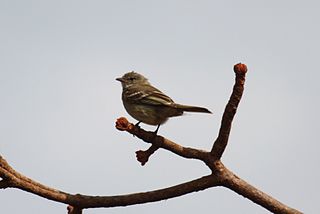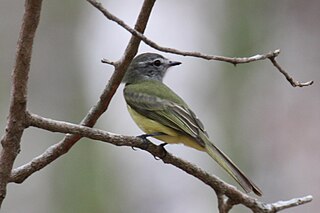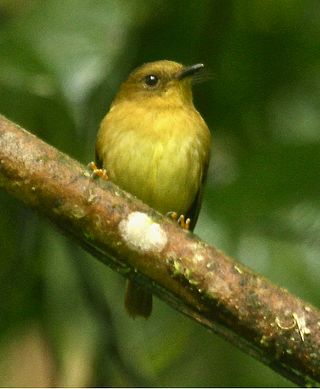
The ochre-bellied flycatcher is a small bird of the tyrant flycatcher family. It is found in Mexico, every Central American country, Trinidad and Tobago, and every mainland South American country except Argentina, Chile, Paraguay, and Uruguay.

The southern beardless tyrannulet is a small passerine bird in subfamily Elaeniinae of family Tyrannidae, the tyrant flycatchers. It is found in Costa Rica, Panama, in every mainland South American country except Chile, and on Trinidad.

The slaty-capped flycatcher is a small passerine bird in the tyrant flycatcher family. It is found from Costa Rica south to Bolivia and east to Venezuela and Trinidad.

The yellow tyrannulet is a small passerine bird in subfamily Elaeniinae of family Tyrannidae, the tyrant flycatchers. It is found in Costa Rica, Nicaragua, Panama, and in every mainland South American country except Chile and Uruguay.

The mountain elaenia is a small passerine bird in subfamily Elaeniinae of family Tyrannidae, the tyrant flycatchers. It is found in Colombia, Costa Rica, El Salvador, Guatemala, Honduras, Nicaragua, Panama, and Venezuela.

The lesser elaenia is a species of bird in subfamily Elaeniinae of family Tyrannidae, the tyrant flycatchers. It is found in Costa Rica, Panama, on Trinidad, in every mainland South American country except Chile and Uruguay, and as a vagrant on Bonaire and Curaçao.

The plain-crested elaenia is a species of bird in subfamily Elaeniinae of family Tyrannidae, the tyrant flycatchers. It is found in Bolivia, Brazil, Colombia, French Guiana, Guyana, Peru, Suriname, and Venezuela.

The sierran elaenia is a species of bird in subfamily Elaeniinae of family Tyrannidae, the tyrant flycatchers. It is found in Bolivia, Colombia, Ecuador, and Peru.

The brown-capped tit-spinetail is a species of bird in the Furnariinae subfamily of the ovenbird family Furnariidae. It is found in Argentina and Bolivia.

The rufous-breasted flycatcher is a species of bird in the family Tyrannidae, the tyrant flycatchers. It is found in Colombia, Ecuador, Peru and Venezuela.

The Inca flycatcher is a species of bird in the family Tyrannidae, the tyrant flycatchers. It is endemic to Peru.

The white-throated tyrannulet is a species of bird in subfamily Elaeniinae of family Tyrannidae, the tyrant flycatchers. It is found in Argentina, Bolivia, Brazil, Colombia, Ecuador, Peru, and Venezuela.

The white-banded tyrannulet is a species of bird in subfamily Elaeniinae of family Tyrannidae, the tyrant flycatchers. It is found in Bolivia, Colombia, Ecuador, Peru, and Venezuela.

The foothill elaenia is a species of bird in subfamily Elaeniinae of family Tyrannidae, the tyrant flycatchers. It is found in Colombia, Ecuador, Peru, and Venezuela.

The greenish elaenia is a species of bird in subfamily Elaeniinae of family Tyrannidae, the tyrant flycatchers. It is found in Mexico, every Central American country, and every mainland South American country except Chile and French Guiana. It has also occurred as a vagrant in southern Texas.

The variegated bristle tyrant is a species of passerine bird in the family Tyrannidae, the tyrant flycatchers. It is found in Colombia, Ecuador, Peru, and Venezuela.

The wing-barred piprites is a species of bird in subfamily Pipritinae of family Tyrannidae, the tyrant flycatchers. It is found in every mainland South American country except Chile and Uruguay.

The bearded tachuri is a Near Threatened species of bird in subfamily Elaeniinae of family Tyrannidae, the tyrant flycatchers. It is found in every mainland South American country except Chile, Ecuador, and Peru.

The bronze-olive pygmy tyrant is a species of bird in the family Tyrannidae, the tyrant flycatchers. It is found in Colombia, Ecuador, Panama, and Peru.

The northern scrub flycatcher is a species of bird in the family Tyrannidae, the tyrant flycatchers. It is found in Aruba, Bonaire, Colombia, Costa Rica, Curaçao, French Guiana, Guyana, Panama, Suriname, Trinidad, and Venezuela.























